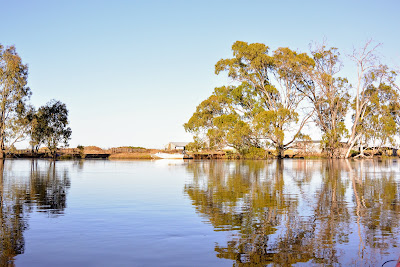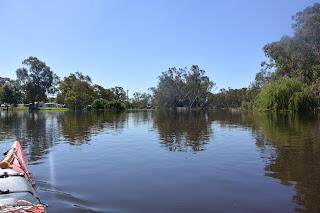 |
| Campsite on a levee: one of the few river side spots above the flood waters. |
Today the weather was perfect for paddling. I awoke early to get a good start and to be up before the mossies. It had been a cold night, too cold for them to be able to fly. I had had a broken nights sleep, dreams of being surrounded by flood waters, mixtures of fact and imagination. Amongst this miasma of semi-consciousness I heard the most unusual sound. Something was approaching the tent. Although things sound bigger at night this did not sound threatening. I couldn’t make it out; heavy breathing and shuffling. It brushed against the tent several times. I thought it might be a possum after my food and tapped against the tent wall to discourage its presence, but to no avail. It wasn’t until I saw a set of spines between the inner and outer tent that I realised what it was, an echidna. It was treating my tent like a log and pushing under it with its long nose, scooping up insect that had sheltered there. It did the same to my boat, knocking my paddle noisy about in the process. On the river a mist was rising, giving it a tropical look. The birds had begun their chorus, some way before dawn, but although I was in an agricultural area, there were still no sounds of man. Breaky was going to be on the water today. If I could get on the water soon I could capture some of that light. By the time I launched they were stirring.
Snake swimming across the river
Benjeroop: morning light. The town's newsletter calls the area 'A little patch of paradise where the waters meet' , however in the summer of 2011 things were not so rosey. Benjeroop was inundated for over a month when floodwaters from the combined high flows of the Loddon and Murray Rivers breached the towns levees in 13 places. The sixty families living there have worked hard to support each other and for the community to recover. In the wake of the floods Prince William visited the community recognising their efforts and bringing attention to their plight.
 |
| Benjaroop |
 |
| Morning light in Cobramunga. |
The mist had lifted, but the trees and rural landscape in the morning light was stunning. They appear so crisp and clear, and in the golden light of early morning it is as if everything is born anew. I drifted a lot, taking it in. Slowly the sounds of work life on the farms began. Early morning jobs. Irrigation has begun, but it was still too early for the pumps. I heard the sounds of machinery being prepared, chicken being fed. The cars starting that would be used to drive kids to school buses. Country kids and their parents have to get up early. On the farms canola is beginning to be harvested, the first hay cut and firebreaks maintained. From the water I get a different perspective. I see the danger and the opportunities the river provides its communities, how they protect themselves from flood, how water is used for the crops and for leisure, I see the first attempts at settlement and the latest and the machinery from everything in between. It is an open book, full of people’s life stories.
Overhanging branches
 |
| Old pump house, slowly collapsing into the river. — in Mellool. |
 |
| One of the more remarkable pump boilers along the river. Why was it encased in brickwork and an iron frame? |
Fairly early in the day, I came across an old steam pump. One of the most interesting on the river. Now with the high water, i was able to get close. It was encased in a framework of brick and had heavy iron bracing. Was this meant to stop it exploding if pushed beyond its limits? Now it sits, overtaken by bush as a symbol of the ingenuity and creativity of those times. Times before weirs, when boilers came by ship from England and farmers became experts through trial and error. When the bush was to be tamed, trees were to cut down and outposts of western civilisation created. The canary island palms and pepper trees scattered through the bush are also a testament to this thinking. Long after all traces of buildings are gone, their presence can be a hint to where farms used to be.
Suggestion not to use sailing boats on the Murray River.
The river is narrow here. It forms what paddle steamer captains used to call ‘the cutting’. Stretching from Barmah to Swan Hill, it circumnavigates the uplifted block of land know as the Cadell Tilt. In a series of earthquakes that lasted over 50,000 years the path of the Murray was blocked, causing it to first flow northward and later south. Both paths exist today, this one and the Edwards-Wakool system in the North. They rejoin at the Wakool junction near Boundary Bend. This southern course of our mighty river is the youngest in the whole system, it may have happened as recently as 800 years ago, or perhaps 10,000. It is still the subject of research. From Echuca onward, the Murray flows through the ancestral Goulburn. In parts of this section, it looks as if that original channel have not changed. Its twisting narrow course is bounded by ancient trees on both sides. They lean into the river, covering up to half of its width, extraordinarily resilient and a wealth of habitat for all that lives here. A cockatoo lets me know that I am trespassing by screaming into its nest. This may have increased the loudness of his call, but what would it be like for its partner sitting on the eggs in there I wonder?
 |
| Murray Downs Homestead |
 |
| Murray Downs Homestead |


























































